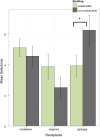Being in a "Green" Building Elicits "Greener" Recycling, but Not Necessarily "Better" Recycling
- PMID: 26731651
- PMCID: PMC4701437
- DOI: 10.1371/journal.pone.0145737
Being in a "Green" Building Elicits "Greener" Recycling, but Not Necessarily "Better" Recycling
Abstract
Previous observational work revealed that transient populations in a sustainable building disposed of waste more accurately when compared to patrons in a non-sustainable building. The current study uses an experimental design to replicate this observed effect and to investigate whether or not the built environment influences motivational factors to impact behavior. We find support that a building designed and built to communicate an atmosphere of sustainability can influence waste disposal behavior. Participants in the sustainable building used the garbage receptacle significantly less and compensated by tending to select the containers and organics receptacle more, which actually resulted in more errors overall. Our findings suggest that building atmospherics can motivate people to recycle more. However, atmospherics alone do not appear to be sufficient to elicit the desired performance outcome.
Conflict of interest statement
Figures






References
-
- Kaiser FG. Using Cutting-Edge Psychology to Advance Environmental Conservation. Eur Psychol. 2014; 19: 81–83.
-
- Gärling T. Past and Present Environmental Psychology. Eur Psychol. 2014; 19: 127–131.
-
- Ernst A, Wenzel U. Bringing Environmental Psychology into Action. Eur Psychol. 2014; 19: 118–126.
-
- Abrahamse W, Steg L, Vlek C, Rothengatter T. A review of intervention studies aimed at household energy conservation. J Environ Psychol. 2005; 25: 273–291.
-
- Abrahamse W, Steg L, Vlek C, Rothengatter T. The effect of tailored information, goal setting and tailored feedback on household energy use, energy-related behaviors and behavioral determinants. J Environ Psychol. 2007; 27: 265–276.
Publication types
MeSH terms
Associated data
LinkOut - more resources
Full Text Sources
Other Literature Sources

